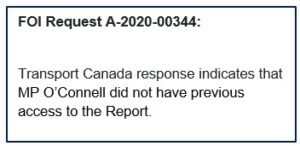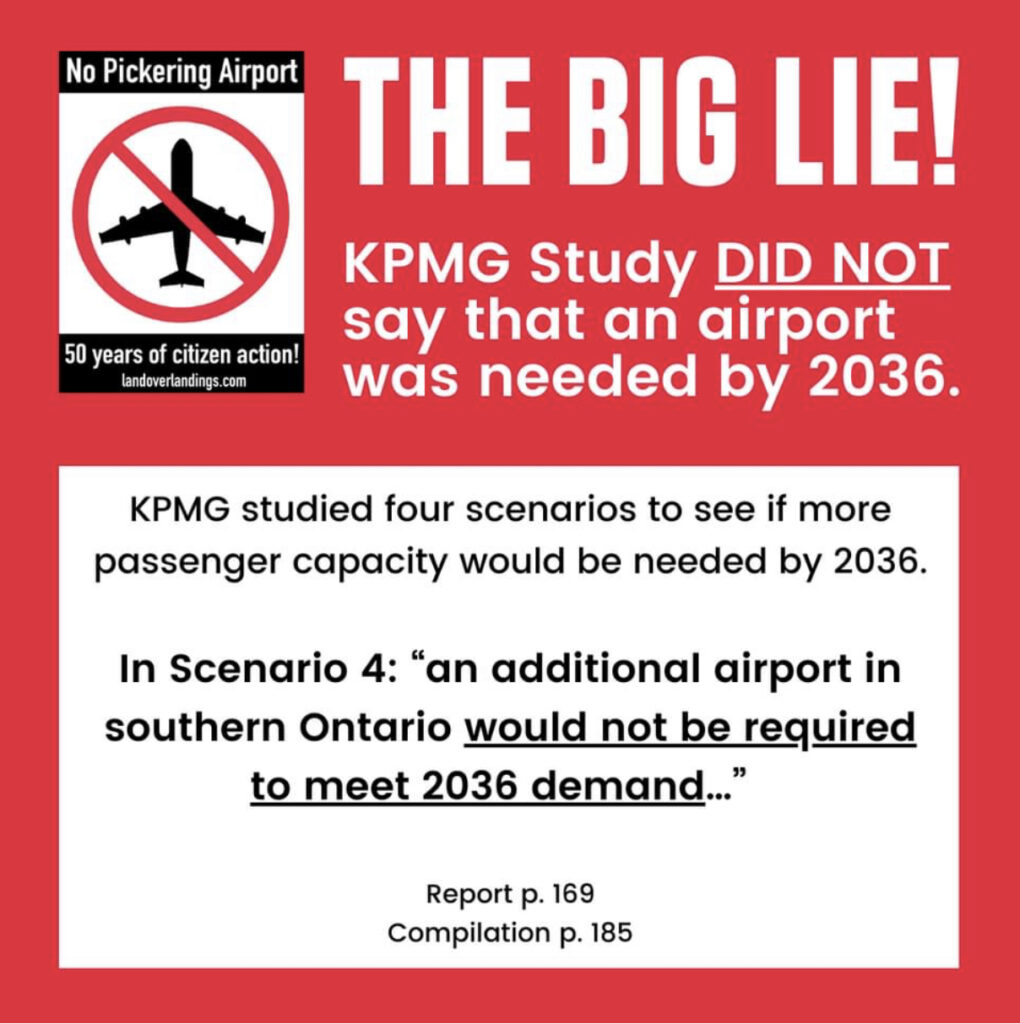By Ted Nickerson
News Flash – November 2021 “The Big Lie Exposed”, a media release by the lobby group Land Over Landings states that the Transport Canada-commissioned study says an airport in Pickering Ontario is not needed by 2036.
https://landoverlandings.com/resources/the-big-lie-exposed/
Oh, really! This pronouncement makes me think of the phrase “If you tell a lie big enough and keep repeating it, people will eventually come to believe it”.

Or the more recent Catherine McKenna variation: 
“I said that if you actually say it louder, we’ve learned in the House of Commons, if you repeat it, if you say it louder, if that is your talking point, people will totally believe it.”
That’s all that Land Over Landings (LOL) is doing here…State, Repeat, Repeat Louder their Big Lie!
I have studied the Transport Canada report, “Pickering Lands – Aviation Sector Analysis” (ASA) and reached quite the opposite interpretation. So yes, I’m a member of what the lobby group Land Over Landing brands as a “small but vocal crowd” that believes that an airport in Pickering is needed by 2036. This group includes five of the local city governments and the majority of their elected officials that overwhelming support the airport.
This is not the first time I or my colleagues have publicly stated it either. Specific to the ASA report, on the pickeringairport.org website, you will find:
- KPMG Report Reaffirms Need for Pickering Airport, March 11, 2020
- O’Connell’s Baffling Misread of the KPMG Report, March 19, 2020
- $4 Billion in “Modest Expansions” Accounting, April 12, 2020
You will also find about 80 other postings in support of the airport, climate change, and rebuttals to the anti-development of the Pickering lands lobby groups.
The Land Over Landings release ends with “Can the individuals who are repeating the Big Lie provide source details for their claims?”. I am one of those individuals, so Challenge Accepted.
Let’s start with LOL’s comment on the purported Transport Canada media release on March 5, 2020, which LOL says made the following statements:
“…that no decision has been made to develop an airport on the Pickering Lands, and that there will be no immediate need for an airport until at least 2038 [sic] … Given the study’s findings, Transport Canada will retain the land for future consideration … there is no business case to support the immediate development of an airport on the Pickering Lands.” …Note: my highlights added
First, this media release was made by Jennifer O’Connell, local MP, not Transport Canada, just a couple of hours after Transport Canada released the 492-page ASA report. An amazingly quick analysis! 
Her release expresses the anti-development/anti-Pickering Airport sentiments of herself and her supporters, but not the sentiments of Transport Canada. For more see: “Just-Released FOI Provides Shocking Insight into Pickering Airport Fight”
Regarding the date “2038”, it occurs in the ASA report only once and never in context of the need for Pickering airport. It is in the footnote on ASA report Page 426 and refers to a study by SNC Lavalin of the Greater Moncton Romeo Leblanc International Airport, Master Plan 2038.
Curiously, 2038 equates to two 10-Year agricultural land lease terms, something previously championed in 2018 by the MP and her supporters! These leases conveniently profit those currently leasing billions of dollars of publicly owned land at just $120 dollars per acre per year.
As to “there is no business case”, ASA Part 3: Revenue Generation and Economic Impact, pages 357 through 491, are explicitly a 130+ page business case, covering multiple development options, financial returns et al. True, parts of it are so grossly redacted, the reader can’t determine which scenario is financially the best, but then again, the Report rejects none of the cases.
To keep this response reasonably easy to read, the following is a brief narrative of what the ASA report says, formatted with appropriate superscripts linking to the actual ASA text also provided in this posting.
The Report immediately makes it clear that one of its prime objectives is to estimate WHEN (1) an airport in Pickering is required, not IF one is required. A Pickering Airport will be required. It will probably open as an Industrial airport. Subject to market conditions, passenger service could follow shortly thereafter.
The Report provides important context (2) regarding the GTAA airports network commercial passenger capability stating that neither Waterloo Airport nor Hamilton Airport will play a significant role in relieving Toronto Pearson Airport in 2036.
The Report estimates that the capacity (3) of the airport network in 2016 to be 94.7 million commercial passengers per year (PAX) and 119.6 million PAX in 2036. These PAX values are based on the theoretical maximum runway capacity and not reflective of any airport’s current or future capacity once all major infrastructure components are considered.
For example, the 2016 airport master plans for Toronto Pearson, Billy Bishop, Hamilton and Waterloo indicate a total capacity of 69.59 million annual passengers. Allowing for the 2017 master plan updates for Toronto Pearson and Waterloo, the total 2036 PAX capacity for these 4 airports would be 92.4 million. The Report overstates the 2016 and 2036 airport capacities by 25.46 million PAX and 27.1 million PAX respectively. Worse yet, the Report does not account for the many other types of utility and cargo aircraft currently using those airports.
The billions of dollars in potentially unsupportable new development required to meet the Report’s 2036 PAX levels are not mentioned at all in the Report.
While clarified later in the Report, this early statement of network capacities leads to an erroneous assumption of when a Pickering airport might be required.
Despite this statement, the Report then quickly identifies that demand in 2036 will exceed (4 A) the capacities and plans of all airport systems at Toronto Pearson Airport. As well, by 2036, Billy Bishop will experience terminal and apron capacity issues, forcing prioritization of consumer passenger operations over essential logistical and utility aviation.
Toronto Pearson and Billy Bishop airports make up about 96+ percent of all commercial passenger traffic in the GTAA. The Report’s demand forecast is based on a very conservative annual growth rate of 2.3 percent (5) considering the actual annual growth rate has exceeded 5 percent for the last 10 years. If this higher 5+ percent prevails, Toronto Pearson airport would reach its capacity limit well before 2036.
To counter the shortfall, the Report suggest implementing capacity improvements (4 B) at existing passenger airports to meet the demand. And of course, if you were to do that, then a new airport would not be required in southern Ontario prior to 2036. Back to my earlier point, such actions would delay Pickering Airport, not eliminate the need for it.
The Report continues to advance the idea of capacity improvements referring to them as “modest expansions” (6 A). In the cases of Waterloo and Hamilton airports, the Report identifies the need for massive infrastructure expansion totalling 152 new gates and 382.5 thousand square metres (4.12 million SF) of terminal expansion (6 B). These investments would align the terminal, aprons etc. infrastructure capacities with the theoretical current runway capacities at these airports.
Those expansions would increase the capacity (7) of Waterloo airport to 19.3 million PAX from 250k PAX, and Hamilton airport to 22.3 million PAX from 1.5 million PAX.

Think about this. In order to delay a Pickering airport until after 2036, the Report suggests building new airport capacity, to be shared by these two airports, to serve an additional 39.85 million PAX (equivalent to 79% of Toronto Pearson’s 2019 PAX throughput), with 152 new passenger gates (18 percent more than currently at Toronto Pearson), and 4.12 million SF of new terminal space (72 percent of Toronto Pearson’s current terminal area).
The Report is clear that these investments are for on-airport site facilities. The Report is silent on any additional offsite infrastructure such as roads, transit, commuter rail, etc. required to support these “modest expansions”. The Report is also silent on the cost to most new air travelers forced to spend time and money to travel up to two additional hours to reach a distant airport.
So, what do you have here? Possibly, the grossest case of NIMBYism, or two future mini-Mirabel’s. The taxpayers of Hamilton and Waterloo Region could be saddled with the stigma of two grossly under-performing passenger airports and the ongoing costs of the roads and infrastructure supersized for the benefit of a few in another region.
Fortunately, the Report recognizes the folly of expanding Waterloo and Hamilton airports (8). These investments would be expensive, and there is insufficient regional demand to justify such expansions. This statement is consistent with the Report’s earlier comment that Waterloo and Hamilton airports will play no significant role in relieving Toronto Pearson.
To their credit, the Report’s authors understand the bigger picture and suggest there is a better development strategy for the Pickering Lands (9). That strategy would factor in stimulating economic growth in the region, the changing airport roles and closures, and improving local passenger access to air services.
The Report carries this thinking forward by looking at six Pickering airport development scenarios (10) (11), ranging from Small Industrial or Specialty Passenger airports up to a Significant Combined Industrial & Special Passenger Airport.
For all scenarios, the Report indicates construction commencing as early as 2026. In-service timing varies by individual scenario, but all dates are in advance of 2036. This tactic is consistent with general airport planning principles – new aviation capacity needs to come online well before the current airports network hits its capacity limit.
The narrative above is based on a portion of my ASA Report analysis. I’m pleased to be included with the aviators, urban planners, elected officials and ordinary citizens, branded by lobbyists as the “small but vocal crowd” that agree that a Pickering airport is needed before 2036.
To the above, it’s worthwhile adding some new information external to the ASA Report.
In 2017, The Region of Waterloo International Airport issued a new airport master plan. The new master plan identifies increasing the passenger capacity to 2.5 million PAX by 2034, from its current 250k PAX capacity. The cost to do so is estimated at $300 million.
As part of their planning process, the Region informed Transport Canada that if Transport Canada wanted airport development greater than 2.5 million PAX, then Transport Canada would have to bear all costs and risks associated with a larger development. Waterloo Region would also consider cancelling its $300 million commitment.
The Report also suggest that 2.3 million otherwise aviation passengers could be accommodated through high-speed rail (HSR) service on the Windsor-Quebec City corridor. Unfortunately, coincident with development of the ASA Report, a study commissioned by the Ontario Ministry of Transportation (performed by consultants Steer Davies Gleave) identified that HSR in Ontario would never be financially viable, and could only exist through continuous and substantial federal, provincial, and regional subsidies.
The current provincial government cancelled its HSR commitments and has commenced limited regional express rail services.
Next, the Land Over Landings media release raises the concern of climate change in the context of aviation. There are several postings already on the pickeringairport.org website specifically addressing global aviation’s commitment to Net Zero by 2050. The major industry Net Zero programs covering inflight operations and airports are endorsed by the Intergovernmental Panel on Climate Change. It’s the industry’s responsibility to now deliver. Enough said.
Lastly, it would be remiss to not address the impacts of the COVID19 pandemic. All dates mentioned above are reflected in the ASA Report or external information pre-pandemic. COVID will change the dates, not just for a Pickering airport but for countless events in our daily lives. Aviation globally and in Canada will recover though the timing remains speculative for the moment.
The COVID 19 pandemic should not be a reason to shelve discussions on or cancel development of the federal Pickering lands.
I’m well aware that the conversation regarding a Pickering airport will continue.
So, to the authors of Big Lie Exposed, I accepted your challenge. I showed you mine. Now show me yours! Publish your undisclosed references from the ASA Report that you claim support your Big Lie.
Pickering Lands Aviation Sector Analysis
Reference Location and Text
- Page 2, Paragraph 3: This study answers the first question: When might an airport on the Pickering Lands be required?
- Page 4, Paragraph 2: In addition, the forecasts suggest that neither Waterloo Airport nor Hamilton Airport will play a significant role in relieving Toronto Pearson Airport in 2036.
- Page 5, Paragraph 3: Overall, based on 2016 infrastructure. operational practices and aircraft mixes. the southern Ontario airports system is projected to have the capacity to support 94.7 million runway PPA. Based on anticipated conditions in 2036, the system is expected to have the capacity to support 119.6 million runway PPA.
- (A) Page 5, Paragraph 5: Scenario 1 results demonstrate that demand in 2036 will surpass the annual runway passenger, terminal apron, terminal building, and groundside parking passenger capacities at Toronto Pearson Airport In addition, demand is expected to marginally exceed terminal apron capacity at Billy Bishop Airport.
(B) Page 5, Paragraph 5: Nonetheless, while current (2016) airport capacities are not sufficient to fully accommodate 2036 demand, capacity improvements can be undertaken within existing passenger airport boundaries to meet the demand, and a new airport is not expected to be required in southern Ontario prior to 2036 from a capacity standpoint.
- Page 198 Table, Page 386: “…aligned with the average growth rate projected for Pearson, at 3% annually…”.
- (A) Page 6, Paragraph 4: Although all four scenarios identify minor capacity deficits, these can be overcome with modest expansions in aircraft apron and air terminal facilities at the airports in the southern Ontario airport system.
(B) Page 210 Table: 3.1: Hypothetical Required Infrastructure Investments
- Page 159, Table 26 2036 System Capacity Summary
- Page 223, Paragraph 3: It is clear that the investments required to fully utilize runway passenger capacity at Hamilton and Waterloo Airports would be expensive and are not currently met by sufficient forecast demand to justify such
- Pages 220 – 222: Section 4 – Factors Influencing the Decision to Develop Pickering Airport
- Pages 279 – 306: Section 5.0 – Airport Development Requirements
- Pages 371 – 376: 2.3 Financial Analysis
Well , guess we will know when toronto builds it’s 6th runway. …..sometime after the 50 new. terminal gates promised in the master plan.